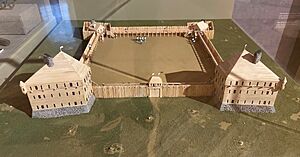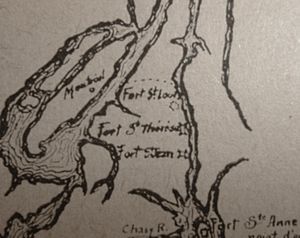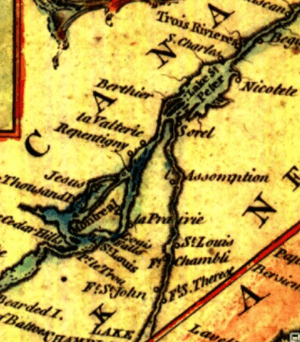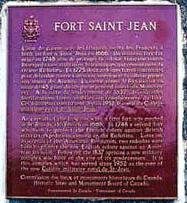Fort Saint-Jean (Quebec) facts for kids
Quick facts for kids Fort Saint-Jean (Québec) |
|
|---|---|
| Saint-Jean-sur-Richelieu, Quebec, Canada | |

Fort Saint-Jean on Richelieu River in Quebec circa 1748
|
|
| Coordinates | 45°17′46″N 73°15′7″W / 45.29611°N 73.25194°W |
| Type | Fort |
| Site information | |
| Controlled by | France; United Kingdom; Continental Army; Canada |
| Site history | |
| Built | 1666 to 1775 |
| In use | 1666 to present day |
| Battles/wars | Siege of Fort Saint-Jean |
| Official name: Fort Saint-Jean National Historic Site of Canada | |
| Designated: | 1923 |
Fort Saint-Jean is an old fort in Quebec, Canada. It sits right on the Richelieu River. French soldiers first built it in 1666. They came from France to help the new colony called New France. It was one of many forts built along the Richelieu River.
Over time, the fort was destroyed and rebuilt many times. But it's one of the oldest military sites in Canada that's been used non-stop, right after Quebec City. Today, it's a National Historic Site. It's also home to the Royal Military College Saint-Jean, a school for future military officers. People have lived and worked at the fort since 1748. The city of Saint-Jean-sur-Richelieu grew up around it. The fort was very important in 1775. It helped the British defend Quebec during an American invasion.
Contents
History of Fort Saint-Jean
The First Fort: 1666
In 1663, the French King Louis XIV took direct control of his New France colony. Before this, rich merchant groups managed it. The Iroquois people often attacked New France. They also tried to take hunting lands from French allies. So, King Louis XIV sent the whole Carignan-Salières Regiment to help.
Their job was to build forts along the Richelieu River and Lake Champlain. This area later became known as the "Forts Valley." They also had to fight the Iroquois. The first Fort Saint-Jean was built in 1666 for this reason. It was a small, square fort with four strong corners. These corners were made of wooden fences called palisades.
The fort was built right after the Chambly rapids. This was a very important spot for moving boats and goods. The French attack on Iroquois land was very successful. A peace treaty was signed between them in 1667. After several peaceful years, the colony's Governor decided to close many forts. These forts, including Fort Saint-Jean, were no longer needed. But because of its great location, Fort Saint-Jean was later used again. Other forts like Sainte-Thérèse and Sainte-Anne were not.
The Second Fort: 1748
The second French Fort Saint-Jean was built in 1748. This happened because of problems between France and England. These problems came from a war called the War of the Austrian Succession. This fort was 200 feet by 200 feet. It had four strong corners, and two of them were made of stone.
This fort was a key stop between Montreal and Fort St. Frédéric. Fort St. Frédéric was located south of Lake Champlain. A road connected Fort Saint-Jean to La Prairie. This made talking between Montreal and St. Frédéric much faster. The second Fort Saint-Jean was sometimes called "Mosquitoes Fort." This was because the area was very swampy.
French soldiers destroyed this fort in 1760 during the French and Indian War. There were not enough men to defend it. A large British army was coming up the Richelieu River to take Montreal. So, the French decided to leave the fort. Before they left for Montreal, they set it on fire. They did not want their enemy to use it. The stone parts of the fort that survived the fire were later used by British troops.
British Fort and American Invasion: 1775
In 1775, the British built a third fort on the same spot. This was because of dangers from the Thirteen Colonies to the south. These colonies were rebelling. A year before the colonies declared independence, two small rebel armies invaded the Province of Quebec. They wanted to defeat the British in Canada. They also hoped Canadians would join them against British rule.
Fort Saint-Jean was very important in defending Quebec. It was the main defense for Montreal against General Richard Montgomery’s army. Montgomery planned to use the Richelieu River to reach Montreal. Then, he would march to Quebec City. The soldiers at Fort Saint-Jean fought bravely. They held out for 45 days during a siege. Finally, they had to give up to the invaders.
The siege of Fort Saint-Jean greatly slowed down the American attack. Montgomery's group arrived at Quebec City in early December instead of mid-October. Only about 300 of his 2,000 men actually reached Quebec City. Bad weather and tired troops meant the Americans failed to take Quebec City. This happened during their attack on December 31, 1775.
British help arrived from England the next spring. The Americans then left and burned the forts they had taken. This included Fort Saint-Jean. But the British feared another American invasion. So, they rebuilt a stronger fort in 1776. They added new walls to it. They also built an important shipyard in Saint-Jean. This yard made shallow boats needed to follow the Americans on Lake Champlain. These boats soon fought in the Battle of Valcour Island.
Fort Saint-Jean in the 1800s
Fort Saint-Jean became less important after the American War of Independence ended in 1783. It was only used as a stop during the second American invasion in 1812–1814. However, the Patriot Revolt in 1837–1838 convinced the British to strengthen the fort again. New buildings were added. Some of these buildings, built in 1839 by the Royal Engineers, are still standing today. They are still used on the site.
In the late 1800s and early 1900s, the fort was mostly a training school. Many groups and regiments trained there. These included The Royal Canadian Regiment and the Royal Canadian Dragoons. During the First World War, the Royal 22e Régiment was formed and trained at Fort Saint-Jean. They were then sent to Europe. After the war, the 22nd battalion became the first official French-speaking Canadian regiment. It was named the Royal 22e Régiment.
The Royal Military College Saint-Jean Years
In 1952, the Royal Military College Saint-Jean was created. Its goal was to help more French-speaking Canadians become officers. They could join the Canadian Army, Royal Canadian Navy, and Royal Canadian Air Force. This made it Canada's first bilingual military college. At first, students could only take their first two years of courses there. They then had to finish their education at the Royal Military College of Canada (RMC) in Kingston, Ontario.
Over time, the college started offering third- and fourth-year courses. In 1985, it was allowed to give its own diplomas. This happened when it received its own Academic Charter. In 1995, the college closed due to budget cuts. Classes were moved to RMC Kingston. To keep the Fort Saint-Jean site in good shape, a non-profit group was formed. It was called the Corporation du fort Saint-Jean.
The "Campus du Fort Saint-Jean" then became a place for businesses and the public. The Corporation rented out some of its school buildings. For example, the Université du Québec à Montréal (UQÀM) used them for local programs. They also rented out other areas for events like banquets and weddings. The House of Commons' Language School also moved there. Many federal politicians came to improve their French.
However, the site never fully stopped its military training. Students in their first year and groups of officers continued to take courses at Fort Saint-Jean. In 2008, the military college reopened. Today, it offers classes to all first-year students. Students past their first year can study International Studies. They can get their degree from the college, as it became a university in 2021. CMR St-Jean is still open to the public. This is special in Canada. There is a museum and a sports center on site. The sports center has an ice rink and a swimming pool.
Fort Saint-Jean Museum
| Established | 1960 |
|---|---|
| Location | Collège militaire royal de Saint-Jean’s old Protestant Church on the campus of the Royal Military College Saint-Jean |
The Fort Saint-Jean Museum started in 1960. It was a private collection of old objects, military items, and historical papers. Over the years, the museum grew its collection. Now, it offers many interesting exhibits. These shows teach about the site's rich military past and history.
The Museum was first in the Old Guardhouse. This building was built by the Royal Engineers between 1883 and 1889. But in 2005, it moved. It is now in the college's old Protestant Church. This new location is better for its exhibits and visitors. The museum has collected about 2,588 pictures. These photos show the history of Collège militaire royal de Saint-Jean from 1952 to 1984. You can see them in an online photo album.
Archaeology at the Fort
In the early 1980s, Parks Canada did archaeological digs at Fort Saint-Jean. During these digs, they found parts of the 1748 French fort's foundations. They also found many interesting old objects from both French and British times.
Now, there is a new digging project. It is a five-year project (2009–2013). It happens in the summer at Fort Saint-Jean. This project works with the Fort Saint-Jean Museum, the Royal Military College of Saint-Jean, and Université Laval. Archaeology students from University Laval do the digging. They work from mid-July to mid-August. They want to learn more about the site's past.
Important Buildings and Features
A metal sign at the college's main gate tells the history of Fort Saint-Jean. It says:
As a result of the Iroquois wars a first fort was erected at St-Jean by the French in 1666. In 1748 a second fort was built to protect the French colony against British military expeditions coming up the Richelieu. Later on, as a result of the American Revolution, two redoubts were built to protect the now English colony against an American invasion. Following the 1837 uprising a new military complex was built on the site of its predecessors. It is this complex which has served since 1952 as the core of the new Collège militaire royal de Saint-Jean.
The DeLery Building is a classroom building. It is named after Gaspard-Joseph Chaussegros de Léry. He was a military engineer who built Fort Saint-Jean in 1748. The Officers' Mess, the La Galissonière Pavilion, and the Montcalm Pavilion are British buildings. They were built in 1839 by the Royal Engineers.
The Richelieu and Iberville Squadrons use the Cartier Building. The Tracy and Jolliet Squadrons use the Champlain Building. Other buildings like Pavillons Vanier, DeLéry, Dextraze, LaHaie, Massey, and the Old Mess are shared by different groups.
See also
 In Spanish: Fuerte Saint-Jean para niños
In Spanish: Fuerte Saint-Jean para niños






